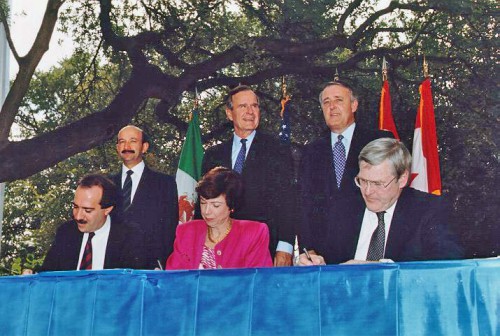The North American Free Trade Agreement (NAFTA), implemented to boost trade between Canada, America, and Mexico, turned 20 years old at the beginning of 2014.
President Obama made the annual trip to meet with his Canadian and Mexican counterparts, but their meeting yielded little substance besides the major talking point; that the three countries should always be doing more to improve trade.
Such was the goal of NAFTA: boost trade between the three neighbors, and grow their economies.
“The rationale for NAFTA is the same rationale for free trade: all countries prosper if they trade freely across their borders and if they specialize in the production of the goods in which they have a comparative advantage,” said David Tuerck, a professor of economics at Suffolk and director of the Beacon Hill Institute.
“Because [Canada, USA, and Mexico] form a contiguous, geographic unit, there would be a lot of opportunities for trade because of the low transportation costs between the three countries,” Tuerck said.
As The Economist pointed out, Mexico benefited the most from the agreement, as its trade with America increased over 500 percent, their manufacturing sector modernized and became more efficient, and the country got more foreign investment and attention.

“I remember all the terrible predictions of doom coming from NAFTA’s opponents…about the giant sucking sound of American jobs leaving for Mexico … but there is no evidence that opening up trade with Mexico led to a loss of jobs in the United States,” Tuerck said.
Unfortunately, the meeting between the three heads of state left several currently important issues, which NAFTA does not account for, unresolved.
First, most of the benefits from NAFTA happened in its early years. “There are only so many benefits to be captured and once those benefits are enjoyed, the trade bloc will settle into a new status quo,” Tuerck said.
Second, to keep growing trade between the three countries, their leaders have to address modern problems.
“Drugs and immigration weren’t the issues 20 years ago that they are now. I don’t think drugs and immigration have much to do with the argument for free trade, but it’s hard to consider how we can expand trade without bringing up the political realities of those two issues. I think the progress toward free trade could be improved if we were able to work out protocols with the Mexican government” over these issues, Tuerck said.
The third is the Keystone XL Pipeline, which could carry oil from Canada to the Gulf of Mexico to be refined. Supporters say it will create jobs and reduce dependence on Middle Eastern energy; opponents say its economic benefits are overstated and that it could exacerbate global warming. Prime Minister Stephen Harper of Canada supports the pipeline and is frustrated with American officials’ reluctance to green light its construction, mainly due to environmental concerns.
Lastly, many analysts point out the hassle caused by congestion at America’s southern border, where it can take hours to get through Border Patrol checkpoints. Reducing the time that tourists and truckers spend waiting in line would likely reduce costs and boost travel.
However, regional trade agreements are not the best way to expand trade, Tuerck said, noting that the main benefit of free trade is that it makes imports cheaper. He said that entering into regional agreements slows the progress towards free trade.
“It would be better, in my judgment, if we avoided all those arrangements and got rid of tariffs and quotas and just unilaterally adopted a free trade policy with the rest of the world. One of the problems with these regional arrangements is that they balkanize the globe. So we have free trade in this region, but we have restrictions with this region,” Tuerck said.
“On the other hand, if we need to enter into these [trade] agreements to get rid of the tariffs and quotas eliminated, then we should do it,” Tuerck said.







